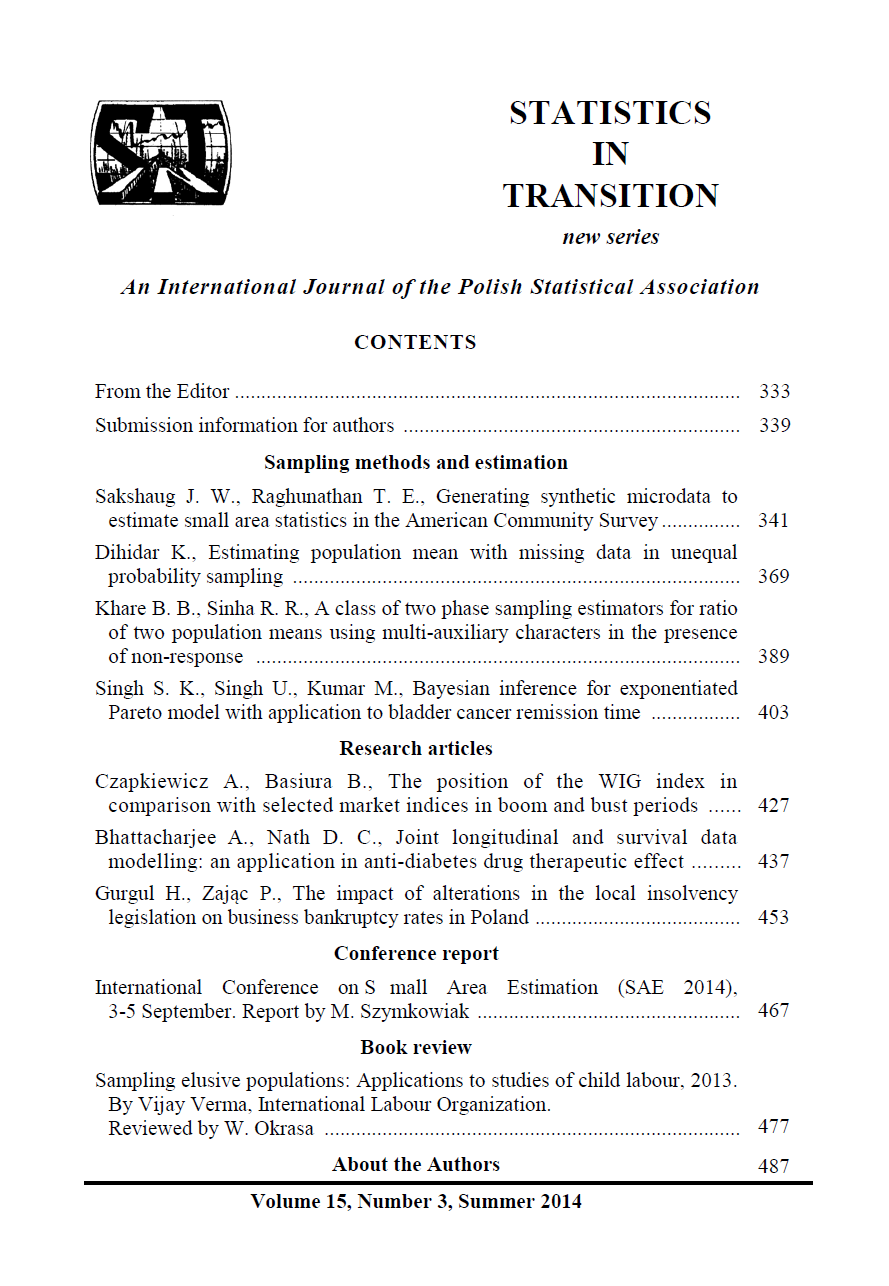ARTICLE
ABSTRACT
The purpose of this paper is to analyze the number of insolvencies in Poland before and after the major bankruptcy code novelization in the second quarter of 2009. Authors check whether the novelization had its intended effect of reducing bankruptcy rates. Therefore, econometric models have been implemented to investigate changes in bankruptcy rates using quarterly data from the period 2003-2013. While controlling the variety of macroeconomic factors that have influenced insolvency rates, we found that after implementation of the novelization the aggregate bankruptcy rates significantly increased
KEYWORDS
small and medium firms, aggregate bankruptcy rates, amendments to the law
REFERENCES
ALTMAN, E. I., (1968). Financial Ratios, Discriminant Analysis and the Prediction of the Corporate Bankruptcy, The Journal of Finance, Vol. 23, pp. 589–609.
ALTMAN, E. I., (1983). Why business fail, Journal of Business Strategy, Vol. 3(4), pp. 15–21.
CHEN, J. H., WILLIAMS, M., (1999). The determinants of business failures in the US low-technology and high-technology industries, Applied Economics, Vol. 31, pp. 1551–1563.
CLAESSENS, S., KLAPPER, L. F., (2005). Bankruptcy around the World: Explanations of its relative use, American Law and Economics Review, Vol. 7, No. 1, pp. 253–283.
CUTHBERTSON, K., HUDSON, J., (1996). The determinants of compulsory liquidations in the UK, The Manchester School of Economic and Social Studies, Vol. 64, No. 3, pp. 298–308.
DEWAELHEYNS, N., VAN HULLE, C., (2008). Legal reform and aggregate small and micro business bankruptcy rates: evidence from the 1997 Belgian bankruptcy code, Small Bus Econ, Vol. 31, pp. 409–424.
EUROPEAN COMMISSION, (2003). BEST project on restructuring, bankruptcy and a fresh start: Final report of the expert, Enterprise Directorate-General.
EVERETT, J., WATSON, J., (1998). Small business failure and external risk factors, Small Business Economics, Vol. 11, No. 4, pp. 371–390.
FISHER, T. C. G., MARTEL, J., (2003). The effect of bankruptcy reform on the number of corporate reorganization proposals, Canadian Public Policy, Vol. 29, No. 3, pp. 339–350.
FOSTER, R., KAPLAN, S., (2001). Creative Destruction, Financial Times.
GREINER, L. E., SCHEIN, V. E., (1988). Power and Organization Development,Addison-Wesley.
HUDSON, J., (1986). An analysis of company liquidations, Applied Economics, Vol. 18, pp. 219–235.
HUDSON, J., (1997). Company bankruptcies and births matter, Applied Economics, Vol. 29, pp. 647–654.
ILMAKUNNAS, P., TOPI, J., (1999). Microeconomic and macroeconomic influences on entry and exit of firms, Review of Industrial Organization, Vol. 15, pp. 283–301.
JOHNSON, P., PARKER, S., (1994). The interrelationships between births and deaths, Small Business Economics, Vol. 6, No. 4, pp. 283–290.
KALLAUR, K., (2009). Bankruptcy and Remedial Act after recent changes, Polish Construction Review, Vol. 4(97), pp. 16–17.
LIU, J., WILSON, N., (2002). Corporate failure rates and the impact of the 1986 insolvency act: An econometric analysis, Managerial Finance, Vol. 28, No. 6, pp. 61–71.
LIU, J., (2004). Macroeconomic determinants of corporate failures: Evidence from the UK, Applied Economics, Vol. 36, pp. 939–945.
PETERSON, R. A., KOZMETSKY, G., RIDGWAY, N. M., (1983). Perceived causes of small business failures:A research note, American Journal of Small Business, Vol. 8, No. 1, pp. 15–19.
SCHUMPETER, J. (1934). The Theory of Economic Development: An inquiry into profits, capital, credit, interest and the business cycle, Transaction Publisher.
SULLIVAN, T. A., WARREN, E., WESTBROOK, J., (1999). Financial difficulties for small businesses and reasons for their failure, US Small Business Administration Office of Advocacy Research Study, No. 188.
VLIEGHE, G. W., (2001). Indicators of fragility in the UK corporate sector, Bank of England Working Paper 146.
WADHWANI, S. B. (1986). Inflation, default premia and the stock market, The Economic Journal, Vol. 96, pp. 120–138.
WORLD BANK, (2001). Principles and guidelines for effective insolvency and creditor rights systems.
ZDYB, M. (2008), Jakie czynniki generują upadłości przedsiębiorstw w Polsce? Przyczyny upadłości przedsiębiorstw w Polsce, Biuletyn E-rachunkowość.
ZEDLER, F., (2003). Prawo upadłościowe i naprawcze–wprowadzenie, Zakamycze
